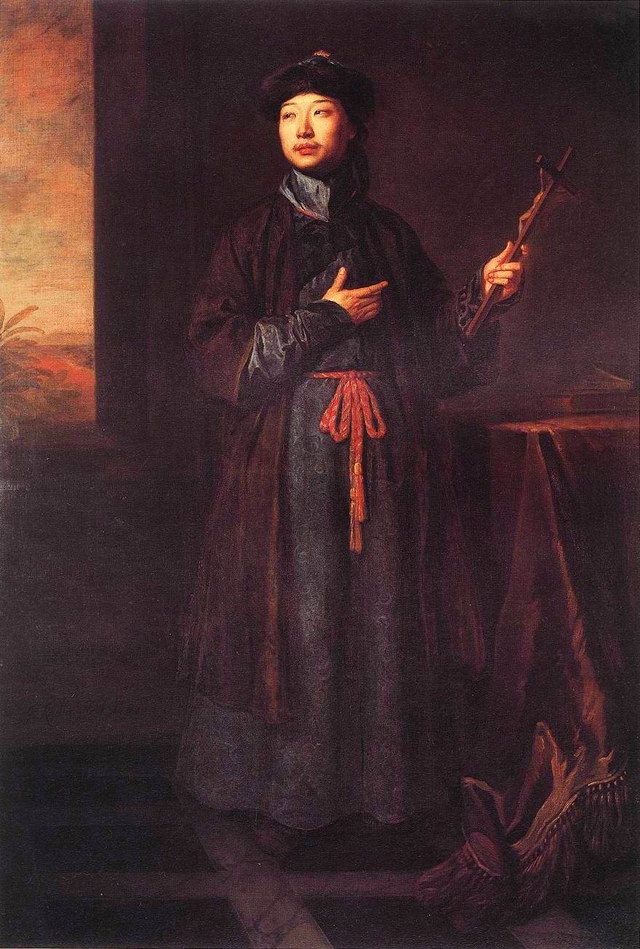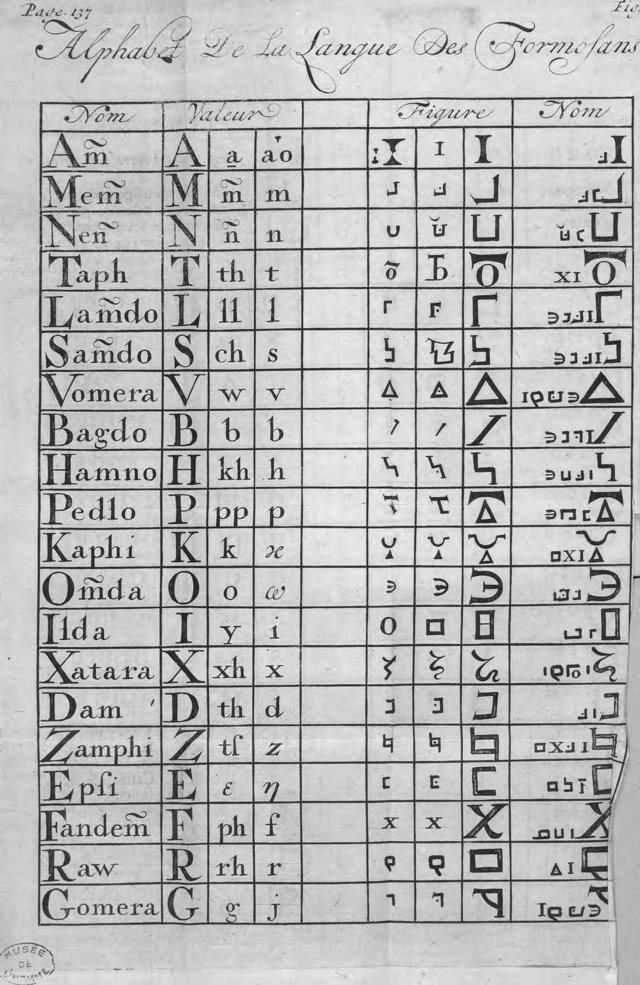Made in Taiwan?: An Eighteenth-Century Frenchman’s Fictional Formosa
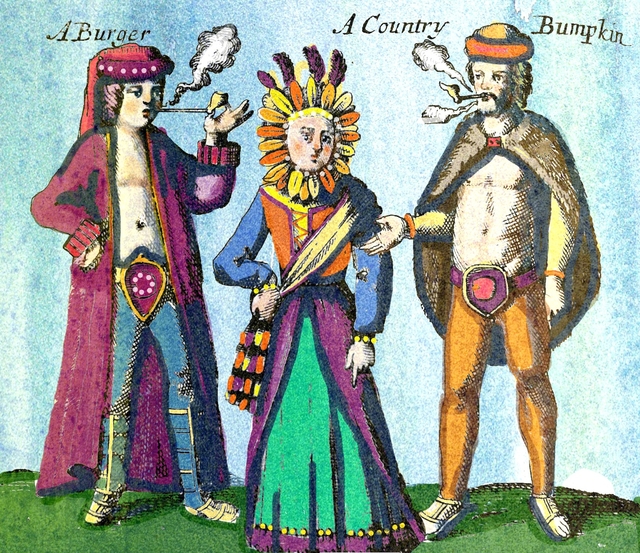
Composite of typical Formosans from Psalmanazar’s Description of Formosa. Colorized by Benjamin Breen
A handsome youth with shoulder-length golden hair sits in a London garret, pondering. He is composing his first book—a work he believes will transform him from a penniless foreigner into a literary cause celebré. But first he must answer a self-imposed question: what do Taiwanese aristocrats eat for breakfast?
Inspiration hits, and his quill nib glides over linen paper. “All who can live without working, eat their Breakfasts about seven of the Clock in the Morning,” the young man scribbles. “First they smoke a Pipe of Tobacco, then they drink Bohea, Green or Sage Tea; afterwards they cut off the Head of a Viper, and suck the Blood out of the Body.” His quill pauses, waiting for the mixture of innocence and archness that comes so easily. “This, in my humble Opinion,” he concludes, “is the most wholsom Breakfast a Man can make.”
Roughly a year later, in a cluttered meeting chamber, a crowd presses around a periwigged physician as he exhibits a “foot of a human Body dried in Tenariffe” alongside a piece of Indian Ocean driftwood carved with cryptic letters. The assembled gentlemen, all fellows of the Royal Society, debate the plausibility of a letter written by a woman “who pretended to live without food.” They scrutinize a rare prize from overseas: “the forked Penis… of the Male Opossum.” A physician dissects the organ then and there, aiming to determine “to what Species in the Praedicament of Animals this Creature might properly be reduced.” A new invention—the world’s first air pump capable of creating a vacuum—makes its debut, the fellows aware that the hand-blown glass bell topping the device could implode at any moment.
At the evening’s close, the same young man—his dreams of literary fame now fulfilled—stands to address the crowd of scientists and savants. An aging Isaac Newton sits at the head of the table. Upon catching sight of the speaker’s pale skin and honey-colored locks, at least one member of the audience privately notes to himself that the foreigner seems to “look like a young Dutch-man.” But the speaker declares that he is actually a native of one of the world’s most remote and mysterious nations. In the twenty-first century we call it Taiwan; in 1704 it was known to Europeans as “Formosa, an Island belonging to the Emperor of Japan.” The man contends that he is a Formosan aristocrat, reared from infancy in the capitol city of Xternetsa and tutored in Greek by an evil Jesuit. He refuses to divulge his Formosan name, but he calls himself George Psalmanazar.
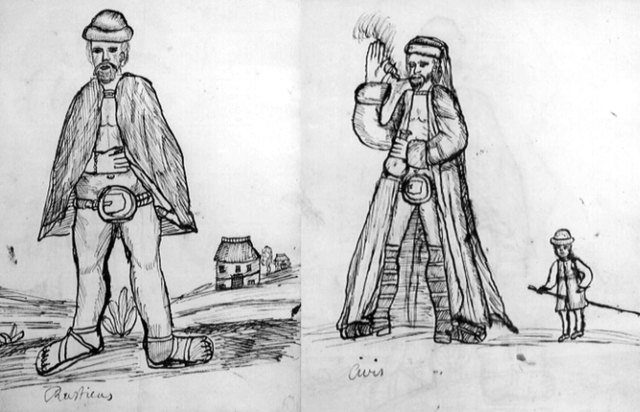
Psalmanazar’s original sketches of various typical Formosans were discovered in Lambeth Palace Library in the 1960s by Frederic Foley. Reproduced in Frederic Foley, The Great Formosan Impostor (1968)
Psalmanazar describes an island nation populated by a skillful and learned people. Yet it is a place which oscillates strangely between civility and savagery. His countrymen possess “a very sharp natural Wit” and are capable of making “Pictures with great Art and Skill,” as well as porcelain dishes, a technology unknown to European craftsmen. Yet “they have no Shoe-makers, Brewers or Bakers,” and they use crude pine torches for lighting. And although Formosan parents refuse to beat their children—a level of tolerance unknown in Europe—they are also capable of appalling violence. In the capital at Xternetsa, Psalmanazar calmly explains, his people have erected an enormous “Tabernacle” where they sacrifice infants to an ox-shaped god, to the tune of approximately 102,000 babies a year.
Clearly, starting their morning with fresh viper’s blood wasn’t the only thing that Formosans did differently.
Who was this man? The available facts remain surprisingly slim. Despite hundreds of years of research by everyone from the father of British Prime Minister Benjamin Disraeli to contemporary scholars at Penn and the National Taiwan University, we still don’t even know Psalmanazar’s real name or place of origin (although he was likely from southern France). We know that elite figures ranging from the scientists of the Royal Society to the Bishop of London initially believed his claims, but he eventually fell into disgrace as competing experts confirmed that he was a liar. Beyond this, we move into the fictional realms that ‘Psalmanazar,’ like a Borges character come to life, summoned into existence with his voice and pen.
Fascinatingly, however, we also possess a confessional autobiography that an aged Psalmanazar wrote as an act of personal penance. The Memoirs of ****, Commonly known by the Name of George Psalmanazar; a Reputed Native of Formosa went to press in 1764, a year after its octogenarian author had died. In old age, Psalmanazar had abandoned his claims of Formosan origin, lamenting his “unaccountable pride, folly, and stupid villainy, in opposition to reason, religion, and all checks of conscience.” Yet he still refused to reveal his real name or place of birth, and his old Formosan habits died hard—not least the “vast quantity of laudanum” (opium tincture) he continued to take on a daily basis, which Psalmanazar attributed to his “vanity and senseless affectation of singularity.”
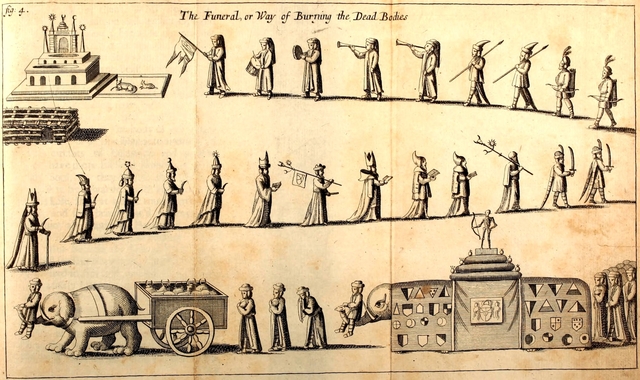
A Formosan funeral procession from Psalmanazar’s Description of Formosa (1704), p. 81. The Internet Archive
Posterity has treated Psalmanazar as little more than a literary footnote. Throughout the nineteenth and twentieth centuries, authors would retell his story as either a humorous anecdote or a tragic tale, depending on their personal inclinations.
But is it also something more?
As an historian of early modern globalization and the drug trade, I first became interested in Psalmanazar due to his surprisingly detailed descriptions of opium addiction. Coming some sixty years before the far more famous account of Thomas de Quincey, they number among the earliest firsthand descriptions of recreational drug abuse in Western literature. I became hooked, however, by his inventions about Formosan culture—like his description of a sorcerer who prophesied that the appearance of “100 Birds Singing” in a nobleman’s garden foretold that the souls of his “Deceas’d Relations had been Transform’d into Stars.”
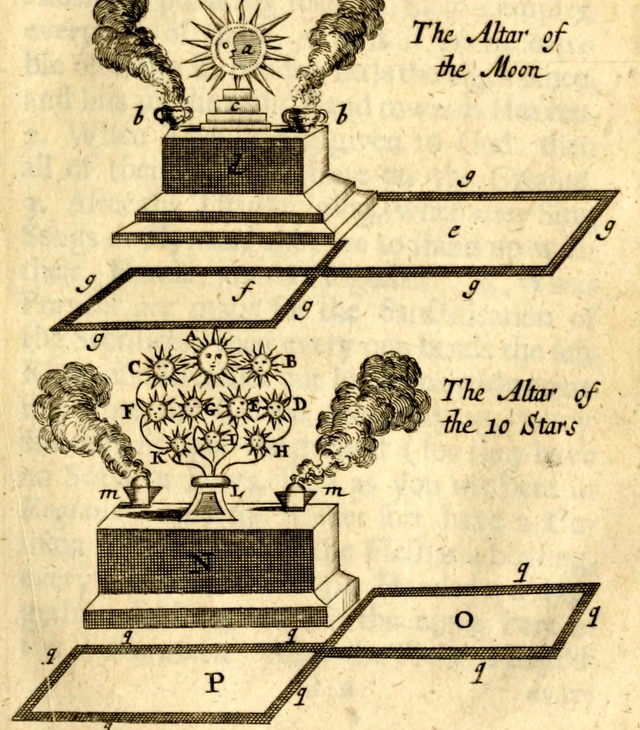
Psalmanazar’s illustrations of the two of the holy altars where he claimed Formosan sacrifices took place, from page 194 of his Description of Formosa (1704). The Internet Archive
As I devoured the immense creativity on display in Description of Formosa, it occurred to me that Psalmanazar was also telling us something fundamental about the origins of modernity. The world of seafarers, merchants, slaves, and transported criminals that created Europe’s overseas empires was built upon elaborate fictions, from Prester John to Jonathan Swift. Although the scale and singularity of his deception made him unique, Psalmanazar was also representative: while he was inventing tales of Formosan cannibalism, his peers were writing falsified histories of pirate utopias, parodic accounts of islands populated by super-intelligent horses, and sincere descriptions of demonic sacrifices.
These works raised profound questions about the nature of truth and fiction. Is the act of travel also an act of authorship, of inventing a reality that we each filter through our individual preconceptions? How do we understand worlds that differ so fundamentally from our own that they almost seem to be other planets? (It is no coincidence that the earliest speculative fictions about extraterrestrial life date from the Age of Sail.) As printers began churning out text after text about ‘the Indies,’ it became painfully apparent that the new generation of traveler-authors were not to be trusted—or at least that surface appearances weren’t always what they seemed.
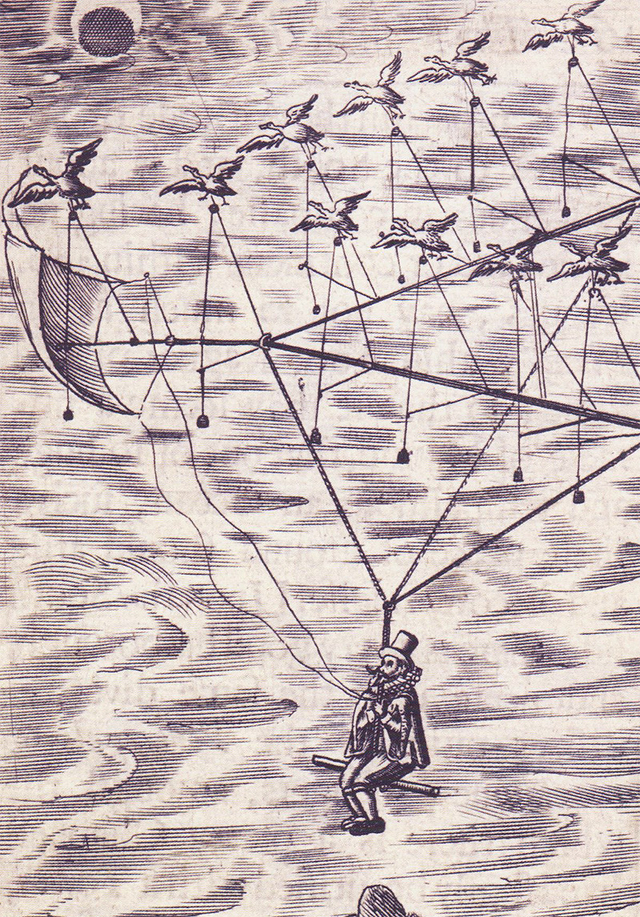
The frontispiece illustration of Bishop Francis Godwin’s work of proto-science fiction, The Man in the Moone, or a Discourse of a Voyage thither by Domingo Gonsales (London, 1638). Godwin’s protagonist, a fictional Spaniard, was portrayed as an intrepid sailor and traveler. Wikimedia Commons
The strange saga of the French traveler François Pyrard de Laval was an early warning of the confusion to come. In 1602, Pyrard shipwrecked on a remote coral reef atoll in the Maldives, where he was imprisoned for five years and became one of the first Europeans to learn the Divehi language. His 1611 account of these adventures was a hit with the European reading public. However, when the text went into a second edition, the publisher added a surprising note. It was buried in the middle of the text, but it was the sort of coy revelation that would have likely caused seventeenth-century readers (as it did me, when I first found it) to do a double take:
The real author of this book is Pierre Bergeron, who having heard people speak of the diverse adventures of Pyrard, when he returned to Paris, took him to his house and made him recount them with all the exactitude that one may remark in this work. As Pyrard was always drunk, Burgeron, in order to discern the truth of his words, made him repeat the same thing several times and at different moments, and when he reported them constantly in the same fashion and without variation, he took them for truthful: if not, he rejected them.
With the rise of novels posing as travel accounts in the latter decades of the seventeenth century (most famously Daniel Defoe’s Robinson Crusoe and Jonathan Swift’s Gulliver’s Travels), the lines between actual traveler and literary impostor blurred even further. In a world without a reliable method of transmitting information, ordinary people found it difficult to distinguish between actual long-distance travelers—like Michael Shen Fu Tsung, the Qing aristocrat who toured Europe as a Catholic convert—and charlatans whose impostures now strike us as painfully obvious.
Psalmanazar’s adult life is literally bookended by his two memoirs, the Description of Formosa (1704), and Memoirs of **** (1764), written some fifty years later and published after his death. But what of the intervening decades?
By 1711, London’s resident Formosan had become a punching bag for the literati. The Spectator, the famed satirical newspaper, kicked off its very first issue with a fake advertisement for an upcoming play that poked fun at Psalmanazar’s tendency to extoll the virtues of cannibalism:
On the first of April will be performed at the Play-house in the Hay-market an opera call’d The Cruelty of Atreus. N.B. The Scene wherein Thyestes eats his own children is to be performed by the famous Mr. Psalmanazar lately arrived from Formosa: The whole Supper being set to Kettle-drums.
As Psalmanazar lost his followers among London’s elite, it would seem that he tried to appeal to more popular audiences by spinning increasingly lurid yarns of Formosan cannibalism. Although the original inspiration for his descriptions is impossible to trace, I believe he drew heavily upon travel accounts describing pre-Columbian ritual cannibalism in Mesoamerica. However, Psalmanazar cleverly couched violent details within a matter-of-fact narrative voice. “When the Victims are a slaying,” he wrote in one representative passage,
Every one may sit upon the ground (for they have no Seats or Pews, such as you use here in England,) only the richer sort have a Cushion to sit on; while the Flesh is a boiling, every one stands with his Hands join’d together, looking towards the upper part of the Tabernacle. After the Flesh is boil’d, every one of the People takes a piece of the Flesh from the Priest and eats it, and what remains, the Priests keep for themselves.
These sorts of accounts reached the ears of the Irish satirist Jonathan Swift, who credited Psalmanazar with inspiring his famous “Modest Proposal” for serving poor Irish children as food. Introducing the piece’s fictional author, Swift wrote that
This Expedient was put into his Head by the famous Salmanaazor, a native of the island of Formosa, who came from thence to London, above twenty years ago, and in Conversation told my Friend, that in his Country, when any young Person happened to be put to Death, the Executioner sold the Carcase to Persons of Quality, as a prime Dainty; and that, in his Time, the Body of a plump Girl of fifteen, who was crucified for an Attempt to poison the Emperor, was sold to his Imperial Majesty’s prime Minister of State… [for] Four hundred Crowns.
In the same period, Psalmanazar began to rely on his displays of extreme drug-taking to impress audiences, smoking enormous tobacco pipes and taking quantities of laudanum that would kill those without a tolerance. He appears to have made a point of portraying Formosa as an island where, as one writer who spoke with Psalmanazar put it, “the ladies… smoke perpetually, and one of Mr. George’s mothers smokes six pounds every day.”
Looking back at the end of his life, Psalmanazar regarded at least “a dozen years” to have been “mis-spent in a course of the most shameful idleness, vanity and extravagance,” including unspecified “gallantry with the fair sex, with many of whom… I was become a great favourite.” Ultimately, Psalmanazar underwent a religious conversion and became an anonymous writer in London’s Grub Street, where he impressed a young Samuel Johnson as “the best man he had ever known,” but continued to abuse laudanum.
Psalmanazar’s own religiously-motivated condemnation of his imposture has strongly influenced later authors’ take on his life. Throughout the eighteenth and nineteenth centuries, authors lampooned the “false Formosan” as little more than a common charlatan. Having spent several years in the literary company of Psalmanazar, though, I’m left with little doubt that he was a sort of genius. His invented Formosan language was so internally consistent that it continued to fool linguistic scholars throughout the nineteenth century. And while his Description is hardly a rival to Defoe or Swift as a literary work, Psalmanazar’s authorship of himself was a masterpiece. His life, as they say, was his art.
Reading Borges’ story about the fictional Pierre Menard, who re-wrote Don Quixote as an original work by occupying the mental universe of Cervantes, it struck me that Psalmanazar’s strange, amoral brilliance might have found a more welcoming home in the twentieth century. Borges wondered whether history might be seen not as “an investigation of reality, but as its origin.”
I wonder whether Psalmanazar would have agreed. But then, I suppose we can ask him: fictional characters, unlike laudanum-addicted impostors, never really die.


